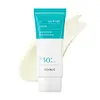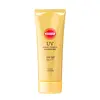What's inside
What's inside
 Key Ingredients
Key Ingredients

 Benefits
Benefits

 Concerns
Concerns

 Ingredients Side-by-side
Ingredients Side-by-side

Water
Skin ConditioningDibutyl Adipate
EmollientPropanediol
SolventDiethylamino Hydroxybenzoyl Hexyl Benzoate
UV FilterBis-Ethylhexyloxyphenol Methoxyphenyl Triazine
Skin ConditioningPolymethylsilsesquioxane
Polysilicone-15
UV FilterMethylene Bis-Benzotriazolyl Tetramethylbutylphenol
UV FilterEthylhexyl Triazone
UV AbsorberNiacinamide
SmoothingDiethylhexyl Butamido Triazone
UV AbsorberGlycerin
HumectantButylene Glycol
Humectant1,2-Hexanediol
Skin ConditioningSodium Hyaluronate
HumectantCamellia Sinensis Leaf Extract
AntimicrobialVanilla Tahitensis Fruit Extract
Skin ConditioningBambusa Vulgaris Water
Skin ConditioningCentella Asiatica Extract
CleansingCaprylyl Methicone
Skin ConditioningCoco-Caprylate/Caprate
EmollientSilica
AbrasivePoly C10-30 Alkyl Acrylate
Emulsion StabilisingPolyglyceryl-3 Methylglucose Distearate
EmulsifyingSodium Acrylates Crosspolymer-2
AbsorbentDecyl Glucoside
CleansingAcrylates/C10-30 Alkyl Acrylate Crosspolymer
Emulsion StabilisingTromethamine
BufferingPolyacrylate Crosspolymer-6
Emulsion StabilisingAdenosine
Skin ConditioningPanthenol
Skin ConditioningDipropylene Glycol
HumectantPentylene Glycol
Skin ConditioningBehenyl Alcohol
EmollientXanthan Gum
EmulsifyingWater, Dibutyl Adipate, Propanediol, Diethylamino Hydroxybenzoyl Hexyl Benzoate, Bis-Ethylhexyloxyphenol Methoxyphenyl Triazine, Polymethylsilsesquioxane, Polysilicone-15, Methylene Bis-Benzotriazolyl Tetramethylbutylphenol, Ethylhexyl Triazone, Niacinamide, Diethylhexyl Butamido Triazone, Glycerin, Butylene Glycol, 1,2-Hexanediol, Sodium Hyaluronate, Camellia Sinensis Leaf Extract, Vanilla Tahitensis Fruit Extract, Bambusa Vulgaris Water, Centella Asiatica Extract, Caprylyl Methicone, Coco-Caprylate/Caprate, Silica, Poly C10-30 Alkyl Acrylate, Polyglyceryl-3 Methylglucose Distearate, Sodium Acrylates Crosspolymer-2, Decyl Glucoside, Acrylates/C10-30 Alkyl Acrylate Crosspolymer, Tromethamine, Polyacrylate Crosspolymer-6, Adenosine, Panthenol, Dipropylene Glycol, Pentylene Glycol, Behenyl Alcohol, Xanthan Gum
Water
Skin ConditioningEthylhexyl Methoxycinnamate 7.48%
UV AbsorberAlcohol
AntimicrobialIsododecane
EmollientPolysilicone-15 3%
UV FilterDiethylamino Hydroxybenzoyl Hexyl Benzoate 2.31%
UV FilterBis-Ethylhexyloxyphenol Methoxyphenyl Triazine 1.5%
Skin ConditioningSilica
AbrasiveDipropylene Glycol
HumectantGlycerin
HumectantPropylene Glycol Dicaprate
EmollientSilica Dimethyl Silylate
EmollientAnthemis Nobilis Flower Extract
MaskingCalendula Officinalis Flower Extract
MaskingCentaurea Cyanus Flower Extract
AstringentChamomilla Recutita Flower Extract
MaskingClematis Vitalba Leaf Extract
Skin ConditioningEquisetum Arvense Extract
AstringentFucus Vesiculosus Extract
EmollientHedera Helix Extract
AntimicrobialHypericum Perforatum Flower/Leaf/Stem Extract
Skin ConditioningSodium Hyaluronate
HumectantSoluble Collagen
HumectantSpiraea Ulmaria Extract
AstringentTilia Cordata Flower Extract
Skin ConditioningAcrylates/C10-30 Alkyl Acrylate Crosspolymer
Emulsion StabilisingBehenyl Alcohol
EmollientBHT
AntioxidantButylene Glycol
HumectantPEG-10 Hydrogenated Castor Oil
EmollientPEG-40 Hydrogenated Castor Oil
EmulsifyingPolyethylene
AbrasivePolyhydroxystearic Acid
EmulsifyingPotassium Hydroxide
BufferingXanthan Gum
EmulsifyingMethylparaben
PreservativePhenoxyethanol
PreservativeWater, Ethylhexyl Methoxycinnamate 7.48%, Alcohol, Isododecane, Polysilicone-15 3%, Diethylamino Hydroxybenzoyl Hexyl Benzoate 2.31%, Bis-Ethylhexyloxyphenol Methoxyphenyl Triazine 1.5%, Silica, Dipropylene Glycol, Glycerin, Propylene Glycol Dicaprate, Silica Dimethyl Silylate, Anthemis Nobilis Flower Extract, Calendula Officinalis Flower Extract, Centaurea Cyanus Flower Extract, Chamomilla Recutita Flower Extract, Clematis Vitalba Leaf Extract, Equisetum Arvense Extract, Fucus Vesiculosus Extract, Hedera Helix Extract, Hypericum Perforatum Flower/Leaf/Stem Extract, Sodium Hyaluronate, Soluble Collagen, Spiraea Ulmaria Extract, Tilia Cordata Flower Extract, Acrylates/C10-30 Alkyl Acrylate Crosspolymer, Behenyl Alcohol, BHT, Butylene Glycol, PEG-10 Hydrogenated Castor Oil, PEG-40 Hydrogenated Castor Oil, Polyethylene, Polyhydroxystearic Acid, Potassium Hydroxide, Xanthan Gum, Methylparaben, Phenoxyethanol
 Reviews
Reviews

Ingredients Explained
These ingredients are found in both products.
Ingredients higher up in an ingredient list are typically present in a larger amount.
Acrylates/C10-30 Alkyl Acrylate Crosspolymer is a synthetic polymer. It is used to thicken and improve the texture of products. Due to its properties, it can prevent water and oil ingredients from separating.
Behenyl Alcohol is a type of fatty alcohol (these are different from the drying, solvent alcohols).
Fatty Alcohols have hydrating properties and are most often used as an emollient or to thicken a product. They are usually derived from natural fats and oils; behenyl alcohol is derived from the fats of vegetable oils.
Emollients help keep your skin soft and hydrated by creating a film that traps moisture in.
In 2000, Behenyl Alcohol was approved by the US as medicine to reduce the duration of cold sores.
Learn more about Behenyl AlcoholYou might know this ingredient as Tinosorb S or Bemotrizinol. It is a UV filter that covers both UVA and UVB rays.
This ingredient has two peak UV absorption peaks ( 310 and 340 nm) and is able to absorb both UV-A and UV-B rays. This ingredient works by preventing UV rays from reaching and damaging your skin.
On top of that - it is highly photostable and helps prevent the photodegration of other sunscreen ingredients such as avobenzone.
Tinosorb S is allowed in the EU, Australia, and Asia. It is close to being approved by the FDA and we'll hopefully get this ingredient in the U.S. by late 2025.
Fun fact: Tinosorb S is the most effective UV absorber at maximum concentration (measured by SPF) permitted in the EU.
This ingredient is oil-soluble, so your oil-cleansers will take this right off at night.
Learn more about Bis-Ethylhexyloxyphenol Methoxyphenyl TriazineButylene Glycol (or BG) is used within cosmetic products for a few different reasons:
Overall, Butylene Glycol is a safe and well-rounded ingredient that works well with other ingredients.
Though this ingredient works well with most skin types, some people with sensitive skin may experience a reaction such as allergic rashes, closed comedones, or itchiness.
Learn more about Butylene GlycolDiethylamino Hydroxybenzoyl Hexyl Benzoate (DHHB) is a chemical UV-A absorber. It is formulated for high UVA protection (320-400 nm).
DHHB is well-liked for:
DHHB has been approved by the EU, Japan, Taiwan, and South America for use up to 10%. Unfortunately, it has not been approved for use in the US or Canada due to slow regulatory processes.
This ingredient is soluble in oils, fats, and lipids.
Learn more about Diethylamino Hydroxybenzoyl Hexyl BenzoateDipropylene Glycol is a synthetically created humectant, stabilizer, and solvent.
This ingredient helps:
Dipropylene glycol is technically an alcohol, but it belongs to the glycol family (often considered part of the ‘good’ alcohols). This means it is hydrating and gentle on skin unlike drying solvent alcohols like denatured alcohol.
As a masking agent, Dipropylene Glycol can be used to cover the smell of other ingredients. However, it does not have a scent.
Studies show Dipropylene Glycol is considered safe to use in skincare.
Learn more about Dipropylene GlycolGlycerin is already naturally found in your skin. It helps moisturize and protect your skin.
A study from 2016 found glycerin to be more effective as a humectant than AHAs and hyaluronic acid.
As a humectant, it helps the skin stay hydrated by pulling moisture to your skin. The low molecular weight of glycerin allows it to pull moisture into the deeper layers of your skin.
Hydrated skin improves your skin barrier; Your skin barrier helps protect against irritants and bacteria.
Glycerin has also been found to have antimicrobial and antiviral properties. Due to these properties, glycerin is often used in wound and burn treatments.
In cosmetics, glycerin is usually derived from plants such as soybean or palm. However, it can also be sourced from animals, such as tallow or animal fat.
This ingredient is organic, colorless, odorless, and non-toxic.
Glycerin is the name for this ingredient in American English. British English uses Glycerol/Glycerine.
Learn more about GlycerinPolysilicone-15 is a chemical UV filter that absorbs UV-B rays.
It is a photostable ingredient used to boost SPF factor and protect products from UV-induced deterioration.
This ingredient is not water-soluble.
Learn more about Polysilicone-15Silica, also known as silicon dioxide, is a naturally occurring mineral. It is used as a fine, spherical, and porous powder in cosmetics.
Though it has exfoliant properties, the function of silica varies depending on the product.
The unique structure of silica enhances the spreadability and adds smoothness, making it a great texture enhancer.
It is also used as an active carrier, emulsifier, and mattifier due to its ability to absorb excess oil.
In some products, tiny microneedles called spicules are made from silica or hydrolyzed sponge. When you rub them in, they lightly polish away dead skin layers and enhance the penetration of active ingredients.
Learn more about SilicaSodium Hyaluronate is hyaluronic acid's salt form. It is commonly derived from the sodium salt of hyaluronic acid.
Like hyaluronic acid, it is great at holding water and acts as a humectant. This makes it a great skin hydrating ingredient.
Sodium Hyaluronate is naturally occurring in our bodies and is mostly found in eye fluid and joints.
These are some other common types of Hyaluronic Acid:
Learn more about Sodium HyaluronateWater. It's the most common cosmetic ingredient of all. You'll usually see it at the top of ingredient lists, meaning that it makes up the largest part of the product.
So why is it so popular? Water most often acts as a solvent - this means that it helps dissolve other ingredients into the formulation.
You'll also recognize water as that liquid we all need to stay alive. If you see this, drink a glass of water. Stay hydrated!
Learn more about WaterXanthan gum is used as a stabilizer and thickener within cosmetic products. It helps give products a sticky, thick feeling - preventing them from being too runny.
On the technical side of things, xanthan gum is a polysaccharide - a combination consisting of multiple sugar molecules bonded together.
Xanthan gum is a pretty common and great ingredient. It is a natural, non-toxic, non-irritating ingredient that is also commonly used in food products.
Learn more about Xanthan Gum